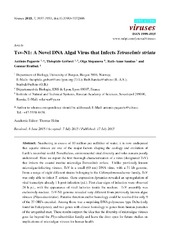| dc.contributor.author | Pagarete, António | |
| dc.contributor.author | Grébert, Théophile | |
| dc.contributor.author | Stepanova, Olga | |
| dc.contributor.author | Sandaa, Ruth-Anne | |
| dc.contributor.author | Bratbak, Gunnar | |
| dc.date.accessioned | 2016-01-11T12:50:34Z | |
| dc.date.available | 2016-01-11T12:50:34Z | |
| dc.date.issued | 2015-07-17 | |
| dc.Published | Viruses 2015, 7(7):3937-3953 | eng |
| dc.identifier.issn | 1999-4915 | en_US |
| dc.identifier.uri | http://hdl.handle.net/1956/10921 | |
| dc.description.abstract | Numbering in excess of 10 million per milliliter of water, it is now undisputed that aquatic viruses are one of the major factors shaping the ecology and evolution of Earth’s microbial world. Nonetheless, environmental viral diversity and roles remain poorly understood. Here we report the first thorough characterization of a virus (designated TsV) that infects the coastal marine microalga Tetraselmis striata. Unlike previously known microalgae-infecting viruses, TsV is a small (60 nm) DNA virus, with a 31 kb genome. From a range of eight different strains belonging to the Chlamydomonadaceae family, TsV was only able to infect T. striata. Gene expression dynamics revealed an up-regulation of viral transcripts already 1 h post-infection (p.i.). First clear signs of infection were observed 24 h p.i., with the appearance of viral factories inside the nucleus. TsV assembly was exclusively nuclear. TsV-N1 genome revealed very different from previously known algae viruses (Phycodnaviridae). Putative function and/or homology could be resolved for only 9 of the 33 ORFs encoded. Among those was a surprising DNA polymerase type Delta (only found in Eukaryotes), and two genes with closest homology to genes from human parasites of the urogenital tract. These results support the idea that the diversity of microalgae viruses goes far beyond the Phycodnaviridae family and leave the door open for future studies on implications of microalgae viruses for human health. | en_US |
| dc.language.iso | eng | eng |
| dc.publisher | Multidisciplinary Digital Publishing Institute (MDPI) | en_US |
| dc.rights | Attribution CC BY 4.0 | eng |
| dc.rights.uri | http://creativecommons.org/licenses/by/4.0 | eng |
| dc.subject | microalgae | eng |
| dc.subject | viruses | eng |
| dc.subject | viral genomics | eng |
| dc.subject | viral taxonomy | eng |
| dc.subject | infection dynamics | eng |
| dc.subject | viral factory | eng |
| dc.subject | horizontal gene transfer | eng |
| dc.title | Tsv-N1: A novel DNA algal virus that infects tetraselmis striata | en_US |
| dc.type | Peer reviewed | |
| dc.type | Journal article | |
| dc.date.updated | 2015-12-22T10:35:11Z | |
| dc.description.version | publishedVersion | en_US |
| dc.rights.holder | Copyright 2015 by the authors; licensee MDPI, Basel, Switzerland | en_US |
| dc.identifier.doi | https://doi.org/10.3390/v7072806 | |
| dc.identifier.cristin | 1276970 | |
| dc.subject.nsi | VDP::Matematikk og naturvitenskap: 400::Zoologiske og botaniske fag: 480::Parasittologi: 484 | |
| dc.subject.nsi | VDP::Mathematics and natural scienses: 400::Zoology and botany: 480::Parasitology: 484 | |
| dc.subject.nsi | VDP::Matematikk og Naturvitenskap: 400 | en_US |

